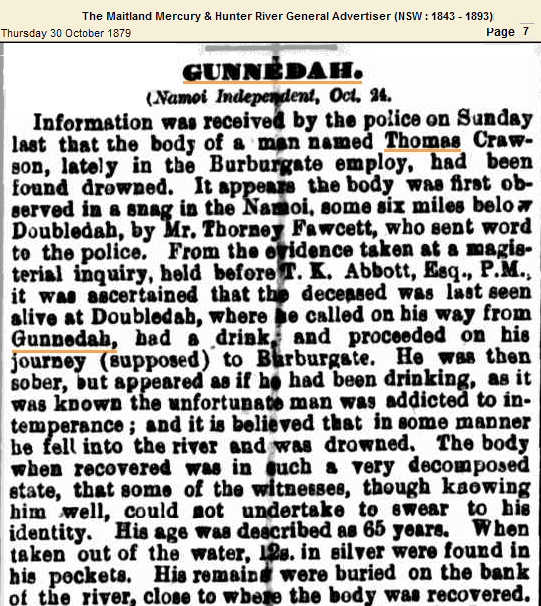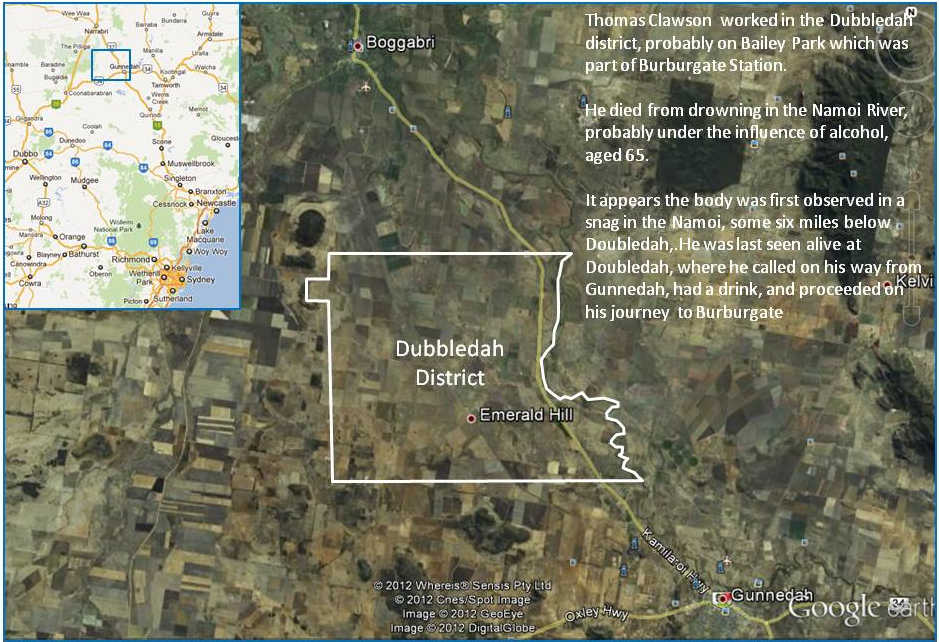1831
27 July |
The record of Thomas' arrival is recorded in "New South Wales, Australia, Convict Indents, 1788-1842, Bound Indentures, 1830-1832" and from this muster we learn:
Convict standing number 31-1044, Thomas Clawson, 39/1767, 18 years, able to read, protestant, single, native of Surrey, errand boy, convicted of robbing a till, tried at Southwark on 4 Jan 1831, sentence to be transported for life, had a former conviction which resulted in 14 days imprisonment, 5' 4¼", dark sallow complexion, brown hair, grey eyes, disposed of as "Chief Justice, Sydney". This entry is annotated CP No. 47/98 dated 30 January 1847 indicating his conditional pardon in 1847.
|
1836
21 November |
Newspaper report in The Sydney Herald of a list of prisoners tried during the recent court sessions: "Joseph Mindle, John Tilley and Thomas Clawson, assault and robbery; not guilty."
|
1836
28 November |
The above offence, regardless of the not guilty verdict, would appear to be the reason behind the next entry in the "New South Wales, Australia, Gaol Description and Entrance Books, 1818-1930" which reads "Thomas Clawson and Joseph Mindle and John Tilley were sent to Newcastle", which is 90 miles north of Sydney, presumably as some kind of punishment. By the end of 1837, however, Thomas was back in Sydney and in gaol; (New South Wales and Tasmania, Australia Convict Musters, 1806-1849).
|
1839
5 September |
Thomas was granted "Ticket of Leave No. 39/1767". A Tcket of Leave allowed convicts to work for themselves provided that they remained in a specified area, reported regularly to local authorities and attended divine worship every Sunday, if possible. They could not leave the colony. By this permission Thomas was required to remain in the Muswellbrook, New South Wales area.
|
1841
25 March |
Ticket of leave No. 41/732 was issued to replace the original 39/1767 which had been mutilated over the years and was duly cancelled; 9 March 1842 - passport 12 months; obtained a conditional pardon no. 47/198 dated 30 January 1847
|
1845
|
Petition number 298/20, Thomas Clawson, Camden 1, recommended for a conditional pardon by Francis Forbes and J B West and W Cox Jnr JP and Thos Kerr and A G Nash(?) MD (Source - New South Wales, Australia, Convict Registers of Conditional and Absolute Pardons 1791-1867)
|
1847
30 January |
Thomas was awarded a conditional pardon, numbered 47/198. This did not allow him to return to the United Kingdom.
|
1852
20 January |
Thomas married Fanny Blackman in Muswellbrook.
|
1854
31 May |
Sarah Sophia Clauson was born, the daughter of Thomas and Fanny Clausen, in Muswellbrook.
Note: Sarah was raised by her mother as part of the Blenman family. Sarah married John Bryant in 1877 in Scone, New South Wales and it is believd that there are descendants in Australia today.
|
1858
|
Thomas' relationship with his wife had broken down by now and Fanny had a child named Gregory Blackman who later took the surname of Blenman when Fanny settled down with Henry James Blenman sometime before 1864.
|
1875
25 February |
According to The Maitland Mercury & Hunter River General Advertiser, Thomas Clawson was in police custody having been "brought up for protection".
"George Thompson, being sworn, states: I am sergeant of police, stationed at Musclebrook(sic); on Saturday night last I received information that a man named Clawson was going about the town in a state of mental derangement, caused by drink; about eleven o'clock I took him from Jones' public House, and confined him in the lock-up. Sentenced to 48 hours imprisonment."
|
1879
30 October |
 The Maitland Mercury & Hunter River General Advertiser The Maitland Mercury & Hunter River General Advertiser
"Information was received by the police on Sunday last that the body of a man named Thomas Crawson (sic), lately in the Burburgate employ, had been found drowned. It appears the body was first observed in a snag in the Namoi, some six miles below Doubledah, by Mr. Thorney Fawcett, who sent word to tbe police. It was ascertained that the deceased was last seen alive at Doubledah, where he called on his way from Gunnedah, had a drink, and proceeded on his journey (supposed) to Burburgate, He was then sober, but appeared as if he had been drinking, as it was known the unfortunate man was addicted to intemperance; and it is believed that in some manner he fell into the river and was drowned. The body when recovered was in such a very decomposed state, that some of the witnesses, though knowing him well, could not undertake to swear to his identity. His age was described as 65 years. When taken out of the water, 12s in silver were found in his pockets. His remains were buried on the bank of the river, close to where the body was recovered."
From research by Shirley Coote:
"I have checked my records and include a map showing Doubledah, it is on the road between Gunnedah & Boggabri. Burburgate Station was over 65,000 acres in the early times. Thomas seems to have a sad life. I have found a hand written list of some employees, one had T Lawson, burr cutter in March 1879 on a salary of £52. This may be him as sometimes the name was written as one heard it. He was working on Bailey Park which was part of Burburgate Station. There would no longer be a marked grave there."

|